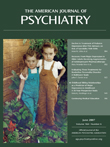Evolving Treatments for Panic Disorder
To The Editor: In the Feb. 2007 issue of the Journal , Barbara Milrod, M.D., et al. (1) reported a randomized controlled trial in which psychoanalytic psychotherapy was superior to applied relaxation in the treatment of panic disorder. Opponents of psychoanalytic therapies often level the criticism that little (if any) research exists that demonstrates the efficacy and durability of these approaches. We therefore applaud the efforts of Dr. Milrod et al. to manualize psychoanalytic therapy and to test its effects in a randomized controlled trial.
One of the great challenges with psychiatric disorders such as panic, however, is that many different interventions can appear to work at any given time. Therefore, the scientific task is to weed out those procedures that may appear to work from those that can be trusted to work reliably, not only because these trusted procedures have passed muster in controlled trials, but also because we have some directly verified knowledge about the mechanism through which they have produced positive outcomes. Where is the evidence elucidating the mechanism by which understanding unconscious conflicts (if they exist) results in the reduction of panic and agoraphobia?
In the past 30 years, we have seen significant advances in understanding the biological, cognitive, and behavioral mechanisms of panic and agoraphobia. This research has informed (and continues to inform) the development of effective treatments for these conditions, including psychological treatments such as cognitive behavior therapy (CBT) (2 , 3) . For example, exposure to interoceptive cues, which is an important component of CBT, is based on experimental research showing that individuals with panic disorder are predisposed to appraise changes in physical state as dangerous (4) . Moreover, studies of the individual components of CBT in the treatment of panic disorder have demonstrated that exposure produces the greatest effect (5) .
We have a scientifically sound model of panic (3) as well as many controlled trials that show the effectiveness of CBT directly derived from this model (6) . Thus, any psychodynamic treatment for panic disorder has to meet a rather high standard. This is not to discount psychodynamic therapy altogether, however. Indeed, interpersonal psychotherapy for the treatment of depression was developed long after CBT was an empirically supported treatment for this condition, and it is now a widely accepted treatment for depression (7) . Interpersonal psychotherapy, however, is based on a psychodynamic theory in which hypotheses about mechanisms of psychopathology have been empirically tested. We therefore await research substantiating the conceptual basis of the psychoanalytic treatment for panic disorder presented in the article by Dr. Milrod et al., as well as a direct comparison of the short- and long-term effects of psychoanalytic treatment and CBT for this condition.
1. Milrod B, Leon AC, Busch F, Rudden M, Schwalberg M, Clarkin J, Aronson A, Singer M, Turchin W, Klass TE, Graf E, Teres JJ, Shear KM: A randomized controlled clinical trial of psychoanalytic psychotherapy for panic disorder. Am J Psychiatry 2007; 164:265–272Google Scholar
2. Clark DM: A cognitive approach to panic. Beh Res Ther 1986; 24:461–470Google Scholar
3. Barlow DH: Anxiety and Its Disorders. New York, Guilford Press, 2002Google Scholar
4. Taylor S: Anxiety Sensitivity. Mahwah, NJ, Erlbaum Press, 1998Google Scholar
5. Deacon BJ, Abramowitz JS: Cognitive and behavioral treatments for anxiety disorders: a review of meta-analytic findings. J Clin Psychol 2004; 160:429–441Google Scholar
6. McIntosh A, Cohen A, Turnbull N, Esmonde L, Dennis P, Eatock J, Feetam C, Hague J, Hughes I, Kelly J, Kosky N, Lear G, Owens L, Ratcliffe J, Salkovskis P: Clinical Guidelines for the Management of Anxiety: Management of Anxiety (Panic Disorder, With or Without Agoraphobia, and Generalised Anxiety Disorder) in Adults in Primary, Secondary and Community Care. London, National Institute for Clinical Excellence, 2004Google Scholar
7. Markowitz JC (ed): Interpersonal Psychotherapy. Washington DC, American Psychiatric Publishing, 1998Google Scholar



